

Countering the Bystander Effect. On March 13, 1964, Kitty Genovese was stabbed and sexually assaulted in front of multiple witnesses (Manning, Levine & Collins, 2007).

The attack went on for around thirty minutes, but not a single person intervened. The police were not notified only after the attack had ended, and Kitty had died. Why did no one help? Why do some bystanders not offer help in an emergency? Kitty’s story is a classic example of the bystander effect, or more specifically, bystander apathy. How does this impact professionals? What can we do to minimize the bystander effect? Notice that something is happening. John Windsor Maybo by Mandt Faculty Posted by MayboByMandt on November 15, 2017 info@maybo.com Please note: All comments are reviewed before being displayed on our website. How to Overcome the Bystander Effect.
Psychologists have long been interested in exactly why and when we help other people.
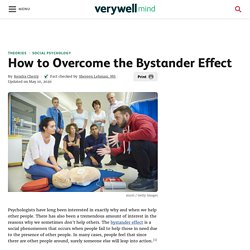
There has also been a tremendous amount of interest in the reasons why we sometimes don't help others. The bystander effect is a social phenomenon that occurs when people fail to help those in need due to the presence of other people. In many cases, people feel that since there are other people around, surely someone else will leap into action.1 While the bystander effect can have a negative impact on prosocial behavior, altruism and heroism, researchers have identified a number of different factors that can help people overcome this tendency and increase the likelihood that they will engage in helping behaviors.2 Some of these include: Witnessing Helping Behavior Sometimes just seeing other people doing something kind or helpful makes us more willing to help others.
Imagine that you are walking into a large department store. Being Observant Being Skilled and Knowledgeable Guilt Feeling Good. Oklahoma State University-Oklahoma City. Be an intervener!
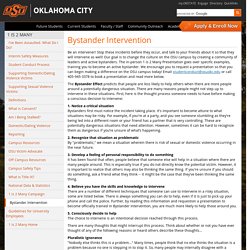
Stop these incidents before they occur, and talk to your friends about it so that they will intervene as well! Our goal is to change the culture on the OSU campus by creating a community of leaders and active bystanders. The in-person 1 is 2 Many Presentation goes over specific examples, training you to become an active bystander. We encourage you to request a presentation so that you can begin making a difference on the OSU campus today! Email studentconduct@osuokc.edu or call 405-945-3378 to book a presentation and read more below.
The Bystander Effect predicts that people are less likely to help others when there are more people around a potentially dangerous situation. 1. 2. 3. 4. 5. There are many thoughts that might interrupt this process. Pluralistic Ignorance "Nobody else thinks this is a problem... " Embarrassment "I don't want to embarrass myself... " Diffusion of Responsibility "Someone else will take care of that... " So, what can you do to intervene? Reducing the Bystander Effect. As discussed, there are a number of factors that magnify the Bystander Effect.
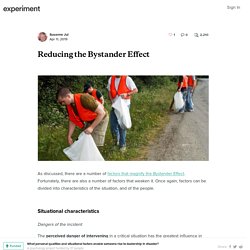
Fortunately, there are also a number of factors that weaken it. Once again, factors can be divided into characteristics of the situation, and of the people. Situational characteristics Dangers of the incident The perceived danger of intervening in a critical situation has the greatest influence in reducing the Bystander Effect. Several explanations could account for the role of perceived danger. Most fundamentally, the arousal: cost–reward model suggests that taking action is a response to the physiological arousal engendered by a critical situation, and that … bystanders intervene in part because they seek to reduce their own arousal [1] Presumably, bystanders experience stronger arousal the more dangerous they perceive the situation to be, making the reward for intervening—in terms of reducing arousal—correspondingly greater.
What Is Diffusion Of Responsibility And How Does It Show Up In Real Life? By: Joanna Smykowski Updated February 13, 2020 Medically Reviewed By: Lauren Guilbeault Content/Trigger Warning: Please be advised, the below article might mention trauma-related topics that include sexual assault & violence which could potentially be triggering.
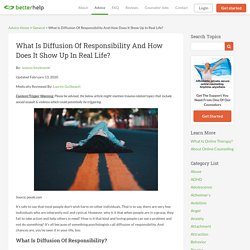
Source: pexels.com It's safe to say that most people don't wish harm on other individuals. 5 steps for overcoming the crippling "bystander effect". Given the choice, Kitty Genovese would rather not have become the subject of social psychology research.
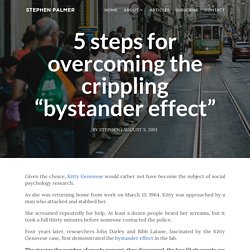
As she was returning home from work on March 13, 1964, Kitty was approached by a man who attacked and stabbed her. She screamed repeatedly for help. At least a dozen people heard her screams, but it took a full thirty minutes before someone contacted the police. Four years later, researchers John Darley and Bibb Latane, fascinated by the Kitty Genovese case, first demonstrated the bystander effect in the lab. Understanding the Bystander Effect.
If you witnessed an emergency happening right before your eyes, you would certainly take some sort of action to help the person in trouble, right?

While we might all like to believe that this is true, psychologists suggest that whether or not you intervene might depend upon the number of other witnesses present. What Is the Bystander Effect? The term bystander effect refers to the phenomenon in which the greater the number of people present, the less likely people are to help a person in distress. When an emergency situation occurs, observers are more likely to take action if there are few or no other witnesses.
Being part of a large crowd makes it so no single person has to take responsibility for an action (or inaction). Bystander Effect. What Is the Bystander Effect? The Science of Empathy. Is the Bystander Effect Real?